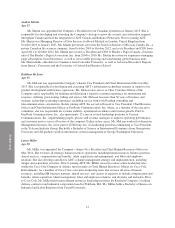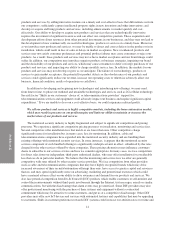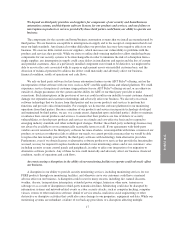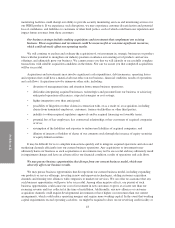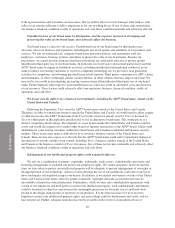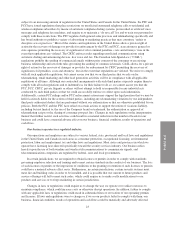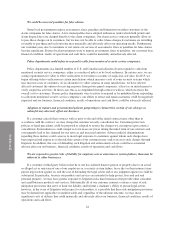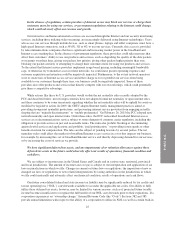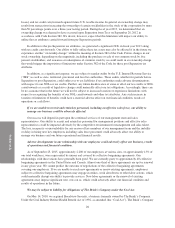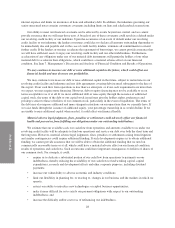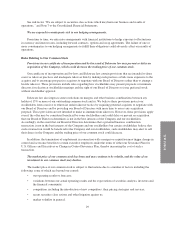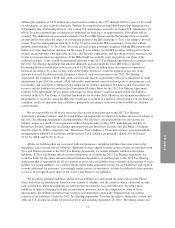ADT 2015 Annual Report Download - page 96
Download and view the complete annual report
Please find page 96 of the 2015 ADT annual report below. You can navigate through the pages in the report by either clicking on the pages listed below, or by using the keyword search tool below to find specific information within the annual report.
FORM 10-K
Shifts in our customers’ choice of, or telecommunications providers’ support for, telecommunications
services and equipment could adversely impact our business and require significant capital expenditures.
Certain elements of our operating model have historically relied on our customers’ continued selection and
use of traditional land-line telecommunications to transmit alarm signals to our monitoring centers. There is a
growing trend for customers to switch to the exclusive use of cellular, satellite or Internet communication
technology in their homes and businesses, and telecommunication providers may discontinue their land-line
services in the future. In addition, many of our customers who use cellular communication technology for their
security and home/business automation systems use our products that rely on 2G cellular technology, and certain
telecommunication providers have advised us that they will discontinue their 2G services in the future. Some
older installed security systems use technology that is not compatible with the newer cellular, satellite or Internet
communication technology, such as 3G and 4G networks, and will not be able to transmit alarm signals on these
networks. The discontinuation of land-line, 2G cellular and any other services by telecommunications providers,
and the switch by customers to the exclusive use of cellular, satellite or Internet communication technology may
require system upgrades to alternative, and potentially more expensive, technologies to transmit alarm signals
and for systems to function properly. This could increase our customer attrition rates and slow new customer
generation. In order to maintain our customer base that uses security and home/business automation system
components that are or could become obsolete, we implemented a three-year conversion program in fiscal year
2013 to replace 2G cellular technology used in many of our security systems at no additional cost to our
customers, and have incurred costs under this program during fiscal year 2014 and fiscal year 2015. We may be
required to upgrade or implement other new technologies, including offering to subsidize the replacement of
customers’ outdated systems, at our expense. Any technology upgrades or implementations could require
significant capital expenditures and also divert management’s attention and other important resources away from
our customer service and sales efforts for new customers. In the future, we may not be able to successfully
implement new technologies or adapt existing technologies to changing market demands. If we are unable to
adapt timely to changing technologies, market conditions or customer preferences, our business, financial
condition, results of operations and cash flows could be materially and adversely affected.
In addition, we use broadband Internet access service, including video streaming services, to support our
product offerings, and we may choose to implement broadband Internet access in our intrusion panels as a
communications option for our services. Video streaming services use significantly more bandwidth than non-
video Internet activity. As utilization rates and penetration of these services increases, our high-speed customers
may use more bandwidth than in the past. If this occurs, we could be required to make significant capital
expenditures to increase network capacity in order to avoid service disruptions or reduced capacity for customers
and potentially increase our cost for the corresponding network usage. See risk factor “Our future growth is
dependent upon our ability to keep pace with rapid technological and industry changes in order to develop or
acquire new technologies for our products and service introductions that achieve market acceptance with
acceptable margins.”
We are subject to securities class actions which may harm our business and results of operations.
We are subject to securities class actions. Following certain periods of volatility in the market price of our
securities, we became the subject of securities litigation as described in Note 7 to the Consolidated Financial
Statements. We may experience more such litigation following future periods of volatility. This type of litigation
may be lengthy, and may result in substantial costs and a diversion of management’s attention and resources.
Results cannot be predicted with certainty and an adverse outcome in such litigation could result in monetary
damages or injunctive relief that could harm our business, results of operations, financial condition or cash flows.
Increasing government regulation of telemarketing, email marketing and other marketing methods may
increase our costs and restrict the operation and growth of our business.
We rely on telemarketing and email marketing conducted internally and through third parties to generate a
substantial number of leads for our business. The telemarketing and email marketing services industries are
22


